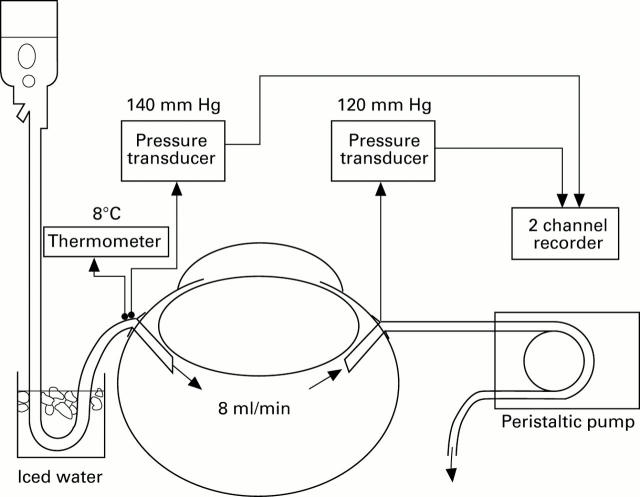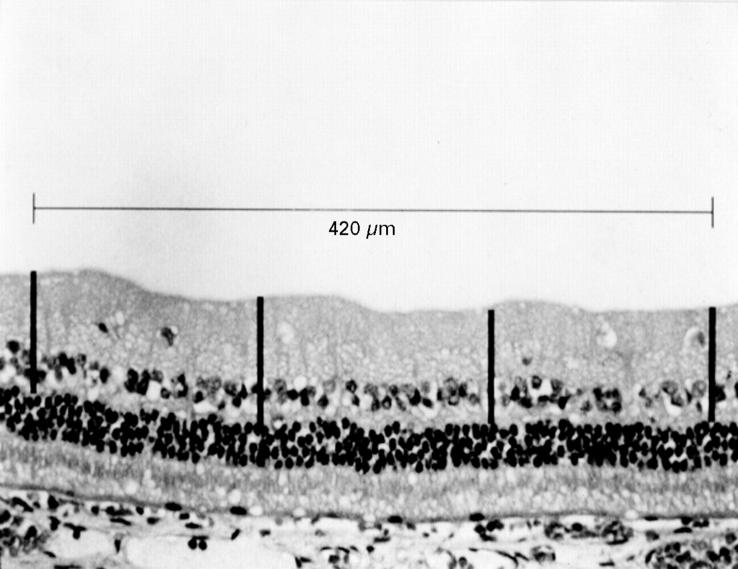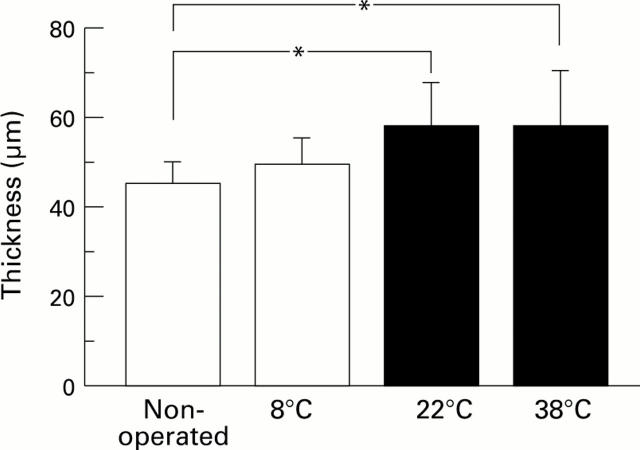Abstract
AIMS—Hypothermic irrigating solutions were used during vitrectomy in pressure induced ischaemic eyes so that their effects on retinal function and histological changes could be investigated. METHODS—After anaesthetised albino rabbits underwent closed vitrectomy, their vitreous cavities were continuously irrigated for 30 minutes at a perfusion pressure of 140 mm Hg. The rabbits were divided into three groups according to their intraocular perfusion temperatures—8°C, 22°C, and 38°C. Electroretinograms were taken before and after irrigation. Glutamate levels in the vitreous were examined after irrigation. Eyes were enucleated on the seventh postoperative day and examined histologically. RESULTS—On the seventh postoperative day, the recovery rate of a-wave amplitudes was significantly lower in the 38°C group than in the 8°C group, and that of b-wave amplitudes was significantly lower in the 38°C group than in either the 8°C or 22°C group. Retinal damage in the 38°C group revealed more severe histological impairment than in either the 8°C or 22°C group. Oedema of the inner retinal layer was significant in both the 22°C and 38°C groups. Glutamates reached peak values 30 minutes after the end of ischaemia in the 38°C group. However, no significant glutamate increases were detected 15 to 60 minutes after ischaemia in either the 8°C or 22°C group. CONCLUSION—Local hypothermia during vitrectomy in acute ischaemic eyes appears to decrease retinal damage.
Full Text
The Full Text of this article is available as a PDF (209.5 KB).
Figure 1 .
The vitreous cavity is irrigated at perfusion pressure of 140 mm Hg. The pressure at the outflow site is maintained at about 120 mm Hg.
Figure 2 .
A sample for the evaluation of inner retinal layer (IRL) thickness, a region with a width of 420 µm at a distance of 6.0 mm from the ora serrata. The IRL thickness was measured and averaged from four values in each region. Vertical bars indicate IRL thickness.
Figure 3 .
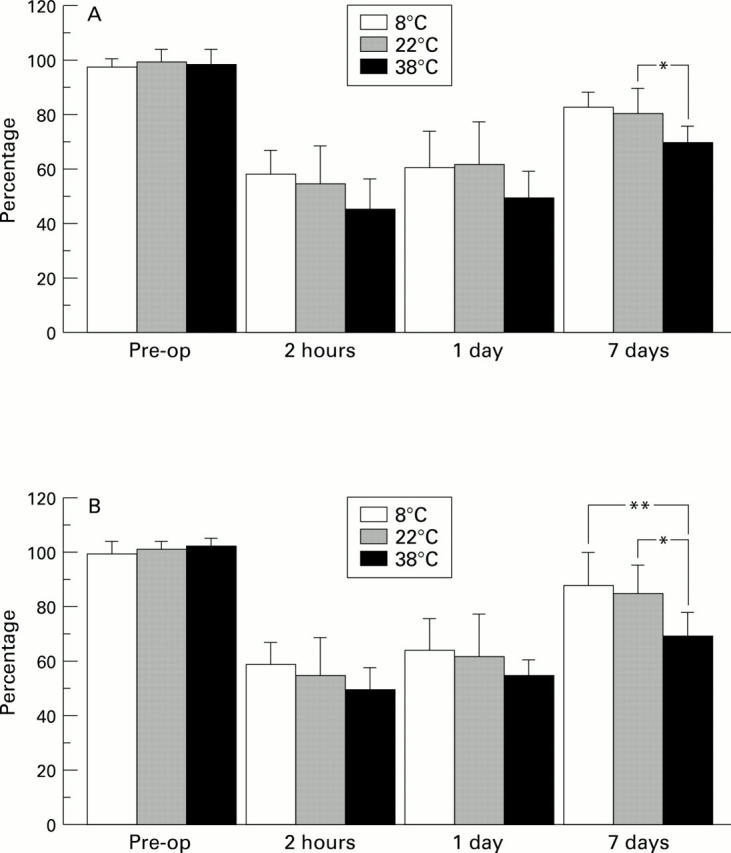
Relative ERG recovery of a-wave (A) and b-wave (B) amplitudes (n=7). *p<0.05, **p<0.01. Error bars represent standard deviations.
Figure 4 .
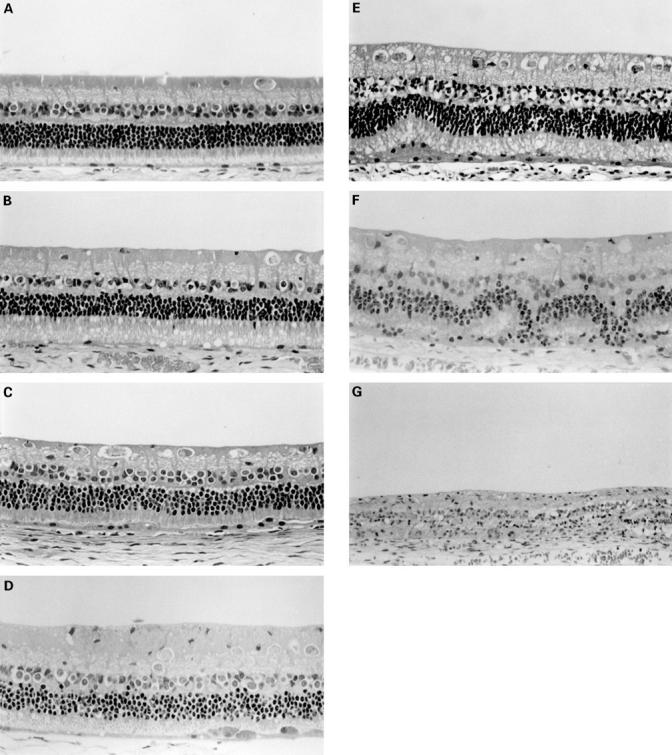
Histological findings of retinal damage by grade (haematoxylin and eosin stained, × 240). (A) Grade 0. Retina of a non-operated eye. (B) Grade 1. Retina that underwent 8°C irrigation. (C) Grade 2. Retina that underwent 8°C irrigation. Proliferation of retinal pigment epithelial cells is observed. (D) Grade 2. Retina that underwent 22°C irrigation. Retinal oedema with inflammatory cell infiltration is observed. (E) Grade 3(a). Retina that underwent 22°C irrigation. (F) Grade 4(a). Retina that underwent 38°C irrigation. (G) Grade 4(b). Retina that underwent 38°C irrigation. Retina is extensively disorganised and thinned.
Figure 5 .
The thickness of inner retinal layer (IRL). Perfusion at 8°C ( n=35), perfusion at 22°C (n=35), and perfusion at 38°C ( n=29) (non-operated eyes; n=105). *p<0.01. Error bars represent standard deviations.
Figure 6 .
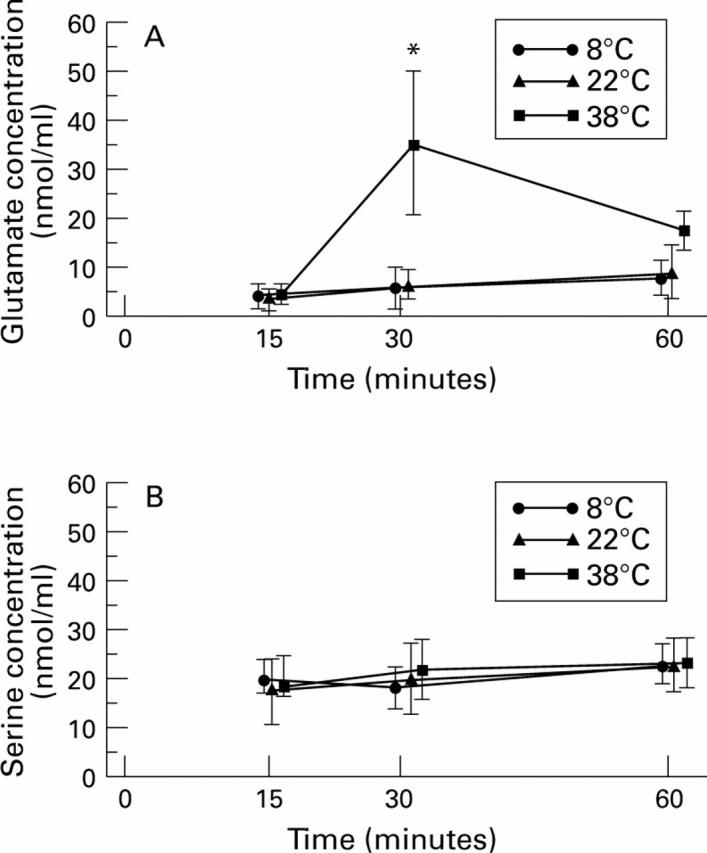
Changes in glutamate (A) and serine (B) levels in the vitreous after ischaemia (n=5). *p<0.01. Error bars represent standard deviations.
Selected References
These references are in PubMed. This may not be the complete list of references from this article.
- Baker C. J., Fiore A. J., Frazzini V. I., Choudhri T. F., Zubay G. P., Solomon R. A. Intraischemic hypothermia decreases the release of glutamate in the cores of permanent focal cerebral infarcts. Neurosurgery. 1995 May;36(5):994–1002. doi: 10.1227/00006123-199505000-00016. [DOI] [PubMed] [Google Scholar]
- Busto R., Dietrich W. D., Globus M. Y., Valdés I., Scheinberg P., Ginsberg M. D. Small differences in intraischemic brain temperature critically determine the extent of ischemic neuronal injury. J Cereb Blood Flow Metab. 1987 Dec;7(6):729–738. doi: 10.1038/jcbfm.1987.127. [DOI] [PubMed] [Google Scholar]
- Choi D. W. Glutamate neurotoxicity and diseases of the nervous system. Neuron. 1988 Oct;1(8):623–634. doi: 10.1016/0896-6273(88)90162-6. [DOI] [PubMed] [Google Scholar]
- Delbarre G., Delbarre B., Calinon F., Ferger A. Accumulation of amino acids and hydroxyl free radicals in brain and retina of gerbil after transient ischemia. J Ocul Pharmacol. 1991 Summer;7(2):147–155. doi: 10.1089/jop.1991.7.147. [DOI] [PubMed] [Google Scholar]
- HIRSCH H., BOLTE A., SCHAUDIG A., TONNIS D. Uber die Weiderbelebung des Gehirns bei Hypothermie. Pflugers Arch. 1957;265(4):328–336. doi: 10.1007/BF00364182. [DOI] [PubMed] [Google Scholar]
- Jabbour N. M., Schepens C. L., Buzney S. M. Local ocular hypothermia in experimental intraocular surgery. Ophthalmology. 1988 Dec;95(12):1687–1690. doi: 10.1016/s0161-6420(88)32956-8. [DOI] [PubMed] [Google Scholar]
- LEWIS F. J., TAUFIC M. Closure of atrial septal defects with the aid of hypothermia; experimental accomplishments and the report of one successful case. Surgery. 1953 Jan;33(1):52–59. [PubMed] [Google Scholar]
- Louzada-Júnior P., Dias J. J., Santos W. F., Lachat J. J., Bradford H. F., Coutinho-Netto J. Glutamate release in experimental ischaemia of the retina: an approach using microdialysis. J Neurochem. 1992 Jul;59(1):358–363. doi: 10.1111/j.1471-4159.1992.tb08912.x. [DOI] [PubMed] [Google Scholar]
- McDowall D. G. The current usage of hypothermia in British neurosurgery. Br J Anaesth. 1971 Nov;43(11):1084–1087. doi: 10.1093/bja/43.11.1084. [DOI] [PubMed] [Google Scholar]
- Nayak M. S., Kita M., Marmor M. F. Protection of rabbit retina from ischemic injury by superoxide dismutase and catalase. Invest Ophthalmol Vis Sci. 1993 May;34(6):2018–2022. [PubMed] [Google Scholar]
- Neal M. J., Cunningham J. R., Hutson P. H., Hogg J. Effects of ischaemia on neurotransmitter release from the isolated retina. J Neurochem. 1994 Mar;62(3):1025–1033. doi: 10.1046/j.1471-4159.1994.62031025.x. [DOI] [PubMed] [Google Scholar]
- Peachey N. S., Green D. J., Ripps H. Ocular ischemia and the effects of allopurinol on functional recovery in the retina of the arterially perfused cat eye. Invest Ophthalmol Vis Sci. 1993 Jan;34(1):58–65. [PubMed] [Google Scholar]
- REDDY D. V., ROSENBERG C., KINSEY V. E. Steady state distribution of free amino acids in the aqueous humours, vitreous body and plasma of the rabbit. Exp Eye Res. 1961 Dec;1:175–191. doi: 10.1016/s0014-4835(61)80024-9. [DOI] [PubMed] [Google Scholar]
- Rinkoff J., Machemer R., Hida T., Chandler D. Temperature-dependent light damage to the retina. Am J Ophthalmol. 1986 Oct 15;102(4):452–462. doi: 10.1016/0002-9394(86)90073-5. [DOI] [PubMed] [Google Scholar]
- Rokkas C. K., Cronin C. S., Nitta T., Helfrich L. R., Jr, Lobner D. C., Choi D. W., Kouchoukos N. T. Profound systemic hypothermia inhibits the release of neurotransmitter amino acids in spinal cord ischemia. J Thorac Cardiovasc Surg. 1995 Jul;110(1):27–35. doi: 10.1016/S0022-5223(05)80006-6. [DOI] [PubMed] [Google Scholar]
- Scheller M. S., Zornow M. H., Fleischer J. E., Shearman G. T., Greber T. F. The noncompetitive N-methyl-D-aspartate receptor antagonist, MK-801 profoundly reduces volatile anesthetic requirements in rabbits. Neuropharmacology. 1989 Jul;28(7):677–681. doi: 10.1016/0028-3908(89)90150-0. [DOI] [PubMed] [Google Scholar]
- Tamai K., Majima A., Yan C. Effects of local hypothermia on uveal blood flow and postoperative inflammation in vitrectomy. Jpn J Ophthalmol. 1995;39(1):43–48. [PubMed] [Google Scholar]
- Tamai K., Toumoto E. Effects of local hypothermia on ischemic eyes in vitrectomy. Jpn J Ophthalmol. 1996;40(2):220–228. [PubMed] [Google Scholar]
- Zilis J. D., Chandler D., Machemer R. Clinical and histologic effects of extreme intraocular hypothermia. Am J Ophthalmol. 1990 Apr 15;109(4):469–473. doi: 10.1016/s0002-9394(14)74615-x. [DOI] [PubMed] [Google Scholar]



